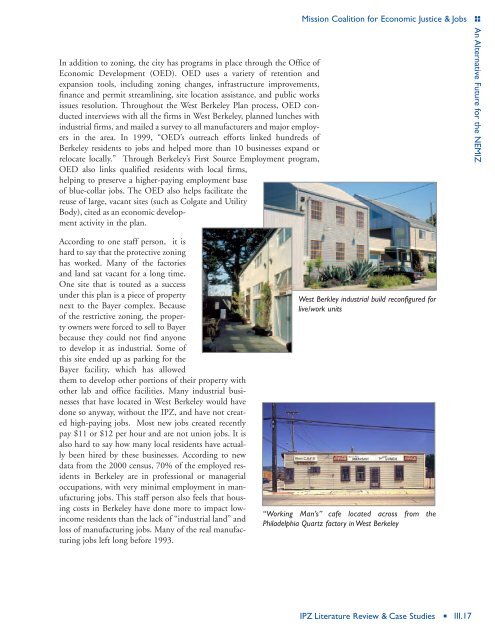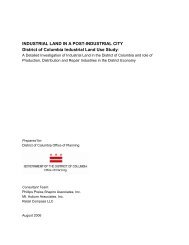An Alternative Future for the North East Mission Industrial Zone
An Alternative Future for the North East Mission Industrial Zone
An Alternative Future for the North East Mission Industrial Zone
You also want an ePaper? Increase the reach of your titles
YUMPU automatically turns print PDFs into web optimized ePapers that Google loves.
In addition to zoning, <strong>the</strong> city has programs in place through <strong>the</strong> Office of<br />
Economic Development (OED). OED uses a variety of retention and<br />
expansion tools, including zoning changes, infrastructure improvements,<br />
finance and permit streamlining, site location assistance, and public works<br />
issues resolution. Throughout <strong>the</strong> West Berkeley Plan process, OED conducted<br />
interviews with all <strong>the</strong> firms in West Berkeley, planned lunches with<br />
industrial firms, and mailed a survey to all manufacturers and major employers<br />
in <strong>the</strong> area. In 1999, “OED’s outreach ef<strong>for</strong>ts linked hundreds of<br />
Berkeley residents to jobs and helped more than 10 businesses expand or<br />
relocate locally.” Through Berkeley’s First Source Employment program,<br />
OED also links qualified residents with local firms,<br />
helping to preserve a higher-paying employment base<br />
of blue-collar jobs. The OED also helps facilitate <strong>the</strong><br />
reuse of large, vacant sites (such as Colgate and Utility<br />
Body), cited as an economic development<br />
activity in <strong>the</strong> plan.<br />
According to one staff person, it is<br />
hard to say that <strong>the</strong> protective zoning<br />
has worked. Many of <strong>the</strong> factories<br />
and land sat vacant <strong>for</strong> a long time.<br />
One site that is touted as a success<br />
under this plan is a piece of property<br />
next to <strong>the</strong> Bayer complex. Because<br />
of <strong>the</strong> restrictive zoning, <strong>the</strong> property<br />
owners were <strong>for</strong>ced to sell to Bayer<br />
because <strong>the</strong>y could not find anyone<br />
to develop it as industrial. Some of<br />
this site ended up as parking <strong>for</strong> <strong>the</strong><br />
Bayer facility, which has allowed<br />
<strong>the</strong>m to develop o<strong>the</strong>r portions of <strong>the</strong>ir property with<br />
o<strong>the</strong>r lab and office facilities. Many industrial businesses<br />
that have located in West Berkeley would have<br />
done so anyway, without <strong>the</strong> IPZ, and have not created<br />
high-paying jobs. Most new jobs created recently<br />
pay $11 or $12 per hour and are not union jobs. It is<br />
also hard to say how many local residents have actually<br />
been hired by <strong>the</strong>se businesses. According to new<br />
data from <strong>the</strong> 2000 census, 70% of <strong>the</strong> employed residents<br />
in Berkeley are in professional or managerial<br />
occupations, with very minimal employment in manufacturing<br />
jobs. This staff person also feels that housing<br />
costs in Berkeley have done more to impact lowincome<br />
residents than <strong>the</strong> lack of “industrial land” and<br />
loss of manufacturing jobs. Many of <strong>the</strong> real manufacturing<br />
jobs left long be<strong>for</strong>e 1993.<br />
<strong>Mission</strong> Coalition <strong>for</strong> Economic Justice & Jobs<br />
West Berkley industrial build reconfigured <strong>for</strong><br />
live/work units<br />
“Working Man’s” cafe located across from <strong>the</strong><br />
Philadelphia Quartz factory in West Berkeley<br />
IPZ Literature Review & Case Studies <br />
III.17<br />
<strong>An</strong> <strong>Alternative</strong> <strong>Future</strong> <strong>for</strong> <strong>the</strong> NEMIZ












